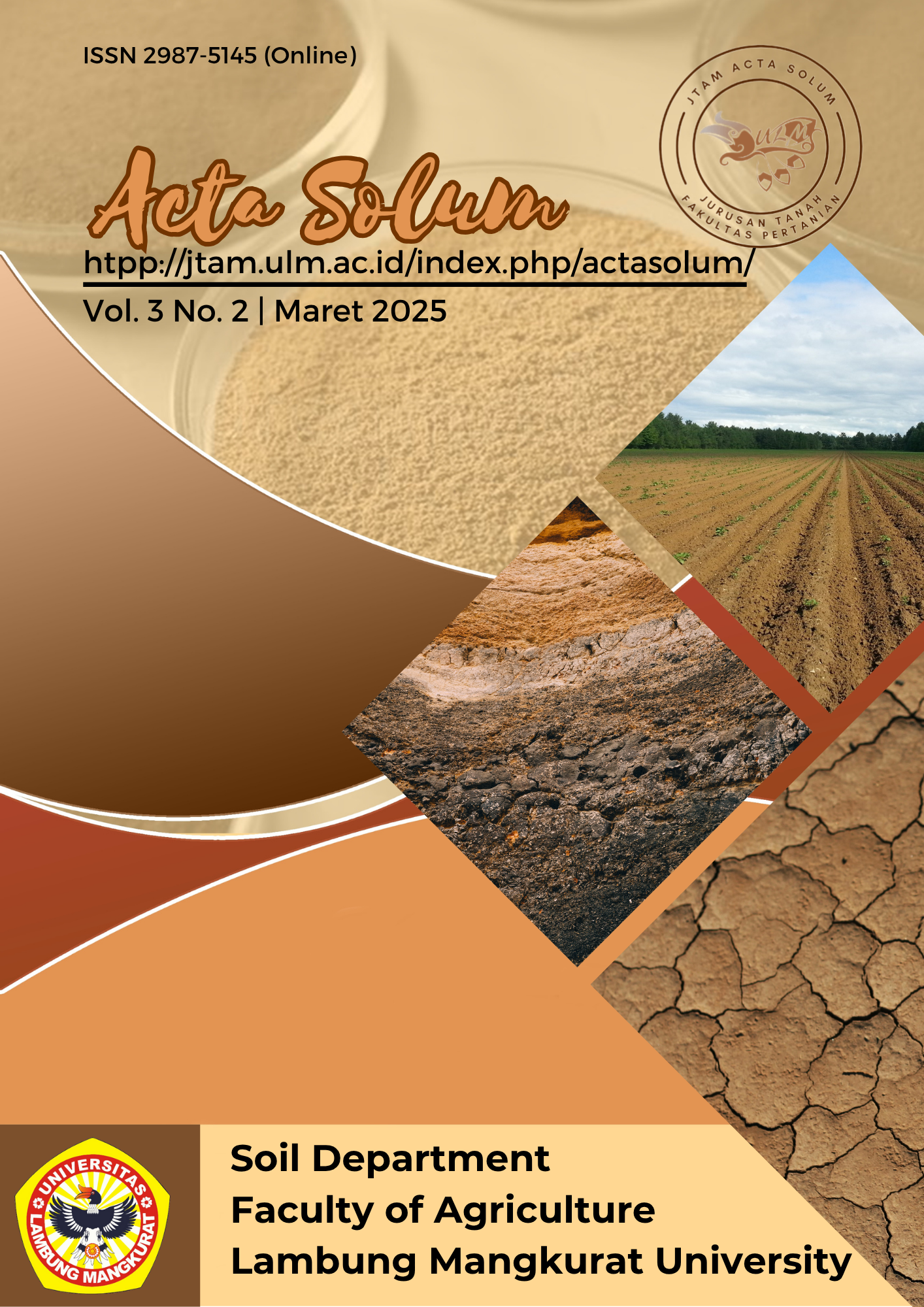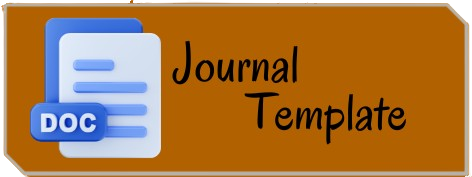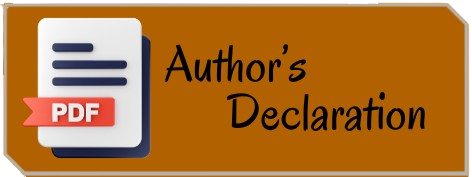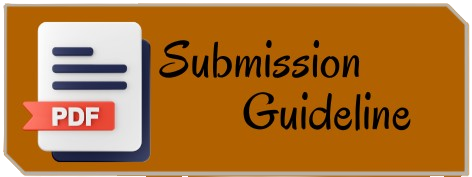Identifikasi Karakteristik Sifat Fisik dan Kimia Tanah Pada Kawasan Rencana Pengambangan Daerah Irigasi Rawa Sabuhur
Identification of Physical and Chemical Soil Characteristics in the Sabuhur Swamp Irrigation Area Development Plan
Abstract
To increase rice production in Tanah Laut Regency, one of the programs implemented by the Tanah Laut Regency Government is the development of swamp irrigation areas in Sabuhur Village. Sabuhur Village has a large swamp area, which has great potential to be developed as agricultural land. However, the success of this development is highly dependent on the suitability of the soil for use as agricultural land. Therefore, testing the physical and chemical characteristics of the soil is a crucial first step to identify the potential and constraints that may occur. The method used is field sampling and laboratory testing. Based on the test results, it can be seen that the characteristics of the physical and chemical properties of the soil at the research location. In terms of soil physical properties at the location, it can be known that soil permeability ranges from 1.86-3.64 cm/h (silty clay), bulk density ranges from 1.01-1.46 g/cm3 (most have exceeded critical values for agriculture), particle density ranges from 1.9-2.86 g/cm3 (mineral soil conditions), porosity ranges from 38.83%-63.31% (silty clay), and aggregate stability ranges from 14%-62.8%. As for the chemical properties of the soil, the total Fe content ranges between 112.19-507.47 ppm, pyrite content between 0.004-0.053% (small pyrite content), CEC ranges between 16.15-30.81 me/100gr (moderate to high soil clay content), and moisture content ranges between 4.88%-29.03. Therefore, the sampling location is not a swamp area because it is mostly mineral soil with a small moisture content. The observation location is a permanently submerged wetland environment.
References
Blanco-Canqui, H., & Lal, R. 2017. Soil structure and particle density. In Soil and Water Conservation: A Celebration of 75 Years (pp. 123–140). American Society of Agronomy. Retrieved from https://www.swcs.org/static/media/cms/75th_Book__online_small_EB8351774A8B2.pdf
Brady, N. C., & Weil, R. R. 2016. The nature and properties of soils (15th ed.). Pearson Education. Retrieved from http://lccn.loc.gov/2016008568
Fitzpatrick, R. W., Powell, B., & Marvanek, S. 2017. Atlas of Australian Acid Sulfate Soils. CSIRO Publishing. Retrieved from https://www.clw.csiro.au/acidsulfatesoils/index.html
Harjianto, M., Sinukaban, N., Tarigan, S. D., & Haridjaja, O. 2016. Land capability evaluation for land use recommendation in Lawo watershed. Jurnal Penelitian Kehutanan Wallacea, 5(1), 1. https://doi.org/10.18330/jwallacea.2016.vol5iss1pp1-1
Hartanto, N., Zulkarnain., Abror, A.W. 2022. Analisis Beberapa Sifat Fisik Tanah sebagai Indikator Kerusakan Tanah pada Lahan Kering. Jurnal Agroekoteknologi Tropika Lembab, 4(2), 107–112. http://dx.doi.org/10.35941/jatl.4.2.2022.7001.107-112
Hazelton, P., & Murphy, B. 2018. Interpreting soil test results: What do all the numbers mean? CSIRO Publishing. https://dx.doi.org/10.1071/9781486303977
He, Y., Xu, Y., Lv, Y., Nie, L., & Hong, W. 2020. Soil bacterial community structure in turfy swamp and its response to highway disturbance. International Journal of Environmental Research and Public Health, 17(21), 7822. https://doi.org/10.3390/ijerph17217822
Imanudin, M.S., Abdul, M., Edi, A., Miftahul. 2020. Study of Limiting Factors and Land Rehabilitation Recommendations for Corn Cultivation in Tidal Swamp Land of Typology C. Journal of Soil Science and Environment, 22(2), 46–55. https://doi.org/10.29244/jitl.22.2.46-55
Istikowati, W., Sunardi, S., Abidin, Z., Surya, A., Fauzan, A., Saputra, D., Sari, E., Hidayanti, N., Rizky, A., & Rahmawati, R. 2025. Pengembangan Desa Sabuhur sebagai Desa Wisata Anggrek Lokal Kalimantan: Development of the Sabuhur Village as a Local Kalimantan Orchid Tourism Village. PengabdianMu: Jurnal Ilmiah Pengabdian kepada Masyarakat, 10(2), 642–652. https://doi.org/10.33084/pengabdianmu.v10i2.8316
Kartika, K., Lakitan, B., Wijaya, A., Kadir, S., Widuri, L., Siaga, E., & Meihana, M. 2018. Effects of particle size and application rate of rice-husk biochar on chemical properties of tropical wetland soil, rice growth and yield. Australian Journal of Crop Science, 12(5), 817–826. https://doi.org/10.21475/ajcs.18.12.05.pne1043
Masganti, M., Susilawati, A., Khairullah, I., & Anwar, K. 2020. Pengendalian keracunan besi untuk peningkatan produktivitas padi di lahan rawa pasang surut bukaan baru. Jurnal Sumberdaya Lahan, 13(2), 103–113. https://doi.org/10.21082/jsdl.v13n2.2019.103-113
Peraturan Pemerintah Republik Indonesia Nomor 150 Tahun 2000 tentang Pengendalian Kerusakan Tanah untuk Produksi Biomassa. 2000. Lembaran Negara Republik Indonesia Tahun 2000 Nomor 4068, Jakarta. Retrieved from https://peraturan.bpk.go.id/Details/54039
Sarah, S., Baharuddin, AB., Bustan. 2024. Sebaran Nilai Kapasitas Tukar Kation (KTK) dan Kemasaman (pH) Tanah di Tanah Vertisol Kecamatan Sakra Kabupaten Lombok Timur. Journal of Soil Quality and Management 3(1), 1–6. https://doi.org/10.29303/jsqm.v3i1.145
Sari, D.P., Riza, S., Suhadi., Ardi, S.A., Ismet, S., Syafri, A. 2024. Evaluasi Kesuburan Tanah di Lahan Kampus 2 Politeknik Pertanian Negeri Payakumbuh, Nagari Sitanang, Sumatera barat, Indonesia. Jurnal Agrium 21(4), 293–300. https://doi.org/10.29103/agrium.v21i4.19581
Sulaiman, A., Sulaeman, Y., & Minasny, B. 2019. A framework for the development of wetland for agricultural use in Indonesia. Resources, 8(1), 34. https://doi.org/10.3390/resources8010034
Supinah, S., Murtilaksono, K., & Wahjunie, E. D. 2017. Analisis Kemampuan Tanah Memegang Air, Permeabilitas, dan Erodibilitas pada Dua Jenis Tanah dan Beberapa Penggunaan Lahan di Kabupaten Bogor. Skripsi Sarjana Fakultas Pertanian Institut Pertanian Bogor, Bogor. Retrieved from https://repository.ipb.ac.id/handle/123456789/126198
Copyright (c) 2025 Ulfa Fitriati

This work is licensed under a Creative Commons Attribution-ShareAlike 4.0 International License.














